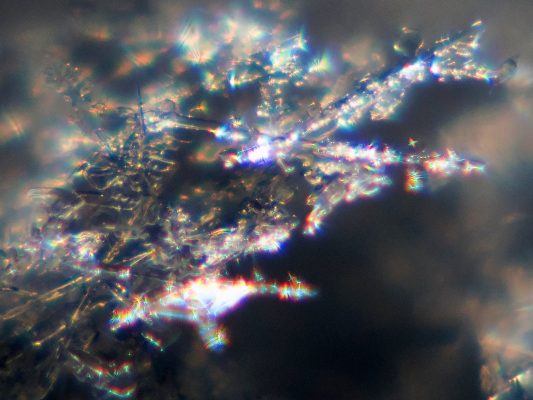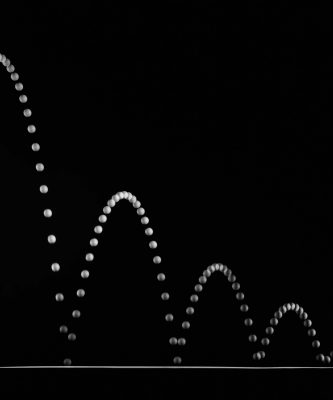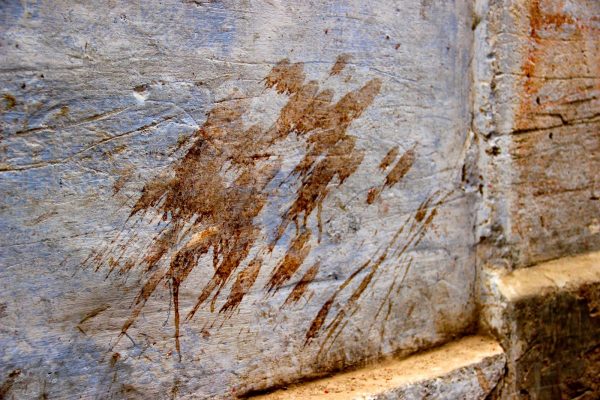In the middle of a summer when I am still a half-child, Mum tells me that this is the time of year when Bà Ngoại (my grandmother) always takes to praying loudly, eating little, turning up the volume on her taped Buddhist chants. I ask why I never noticed. You wouldn’t, Mum says. She hides it from the children. I ask what is wrong. Without thinking, she replies, The ghosts are free. When I ask what she means, Mum pauses, remembering that this is one fear she can choose to save me from. She returns with one of her favourite warnings. Don’t dig in too much — something she also says to stop me from scratching mosquito bites, or when I ask her to translate an old song she finds too sad.
It is one of the rare times when Mum, Bà Ngoại and I are all together at Bà Ngoại’s house in Greater London, and Mum wants us to stay happy. Bà Ngoại lives under a flight path, and so the distant howl of aeroplanes overlays every sound in the house — the recorded monk chants, the singing bowl Bà Ngoại taps after praying, her sudden giggles.
Mum hands me a bowl of microwaved porridge and tells me to take it to Bà Ngoại. She’ll eat if you’re the one to give it, she says. And remember to speak to her gently.
*
Mum lets go of the ghost story in fragments. She finds a picture of a man in red robes standing on two lotuses, with a ball of yellow light behind his head. In one hand, he holds a golden staff, and in the other, a big blue orb. This is Địa Tạng Vương Bồ Tát, Mum says. She pauses to find the right translation. The Buddha of the underworld.
Like many of the stories Mum tells me, it starts with a suffering woman. This one had a son, Mục-kiền-liên — a young monk. Unable to afford anything else, the woman made a small offering of rice to the temple. After this gesture was spurned by senior monks, she is said to have killed and cooked a dog, and tricked the monks into eating it. As punishment, she went to Hell and became a spirit cursed with eternal hunger. But the son was a good boy, Mum says. He followed her to Hell to bring her a bowl of rice, but it turned to fire in her throat.
The pulp inside my teeth starts to throb, and I salivate. I imagine a girl with a face like mine, but with a mouth that dissolves every time she touches food. I ask if Mục-kiền-liên’s mother was saved.
Yes, Mum says, and then she closes her eyes as she tries to remember how. She tells me that Mục-kiền-liên spoke with the Buddha, who advised him to make temple offerings at the end of monsoon season. In this way, Mục-kiền-liên’s goodness could be transferred to his mother’s spirit, freeing her from Hell.
Mum points again at the picture of the man in red robes. That is how Mục-kiền-liên became Địa Tạng Vương Bồ Tát, the Buddha of the Underworld, she says. She taps his staff. He uses this to open the gates to Hell. She taps his blue orb. This lights the way out.
Mum tells me that since then, Hell’s hungry ghosts have always been free to wander the Earth during the seventh lunar month. Sometimes they get too close. Your Bà Ngoại thinks she can scare them away if she prays loudly enough.
I think of the offerings we leave on Ông Ngoại’s shrine. Is Granddad a hungry ghost? I ask. Mum frowns. Of course not, she says. He always had a good character. When Mum says this, she always means the same thing: to have a good character is to be brave, honourable, and willing to protect the family. She explains that hungry ghosts only arise from those who commit a grave sin in life — like Mục-kiền-liên’s mother — or from those who have no one to remember or venerate them. But it seems that good or bad, cursed or blessed, all ghosts need feeding. Mum tells me that if we stop leaving offerings for our dead, their necks grow long and thin, and it becomes harder for them to swallow.
*
In Vietnam, ghost month is marked by the Vu Lan Festival, during which people not only remember the hungry ghost story, but also honour dead family members — especially mothers. Having been raised in the UK, I’ve never been in Vietnam during the Vu Lan Festival. When I ask my family more about it, one of my uncles tells me that he remembers leaving fruit, biscuits and sugarcane in the yard as offerings to wandering souls, so that they would not enter the home and bring bad luck. In the house, salted rice, cups of water and three incense sticks were arranged on the shrine, and the family gathered to pray for their ancestors — the ghosts of their blood. Once the prayers were over, and the spirits — both strange and familiar — had passed through the food, the children were allowed to run out to collect the sweet things from the yard.
On auspicious days — during the month of hungry ghosts, Tết (Lunar New Year) and death anniversaries — we do not eat meat or leave it on the shrines. Mum says that we cannot carry animal death on our bodies, or the blessings will not catch us. This means that our ancestors, including Ông Ngoại, usually receive a mixture of đồ kho chay — tofu stewed with courgettes, carrots, mushrooms and daikon — vegetable chả giò and sticky rice bundles with mung beans at the centre. Sometimes, there is also chè đậu trắng: sticky rice pudding with black-eyed peas and coconut milk. To me, this is the dish that looks most like ghost food — translucent and shimmering.
After losing Ông Ngoại, Bà Ngoại gave up eating meat as an act of mourning, and never went back to it. One of my aunts jokes that Ông Ngoại only became a vegetarian after dying.
*
As I grow older, I begin to avoid meat more and more until — like Bà Ngoại, Ông Ngoại, and the monks I see in the Fo Guang Shan London Temple during Tết — I am completely vegetarian. When I was young, even before I knew about the ghost mother’s curse, I was so fussy about meat that I kept a pair of kitchen scissors beside me at mealtimes to cut off the parts I didn’t want. Mum told me I had to eat up, that we might not always have too much. She sliced up my pork for me, then pushed most of the chunks to one side of my plate. Three cubes remained behind. There, she said, pointing. That is all each of us had.
I had heard this story many times before. When rationing began in Saigon during the Vietnam War, Mum remembers queuing publicly in the daytime and bartering secretly at night. Sometimes, even the most vital items could only be obtained on the black market — baby milk, medicines, rice. But you had to be careful, she told me. The painkillers were sometimes just buttons dipped in white powder.
Mum fled Vietnam and came to the UK as a refugee a few years after the end of the war, along with her parents and siblings. They left almost everything behind except for the ghosts, and the language they spoke to them in. These were both the ghosts they had carried from birth — ancestors, old gods, the cursed spirits from stories — and the ghosts that rose from the war. The new ghosts were shapeshifters, most visible at night. Sometimes, they wore the faces of the soldiers who raided family homes for hidden gold and other valuables. Sometimes, they appeared as the old men who were taken away to re-education camps, or young girls after weeks of eating too little.
I wonder how Mum learned to carry such hunger, whether it felt like she too was turning into a ghost. I’ve never known how to fill the spaces that still exist inside her. All I can do is let her watch me eat.
*
There are so many ghost tastes from Mum’s childhood: things she never found in the UK and so can never pass to me. She knows this, but sometimes decides to try anyway.
On one of her rare weekends off work, she goes to the Asian supermarket and buys mung beans, two kinds of flour, sugar, coconut milk, yellow and green food colouring and a bottle of dark green pandan extract. She tells me she is making bánh da lợn — steamed layer cake. The literal translation is ‘pigskin cake’, which makes me anticipate something tender and chewy. In the pictures she’s printed, the cake’s surface reminds me of the glossy leaves of our jasmine plant.
Mum has never had the time or energy to make a Vietnamese dessert in England before. I watch her blend the mung beans into a paste and mix two bowls of batter — one yellow, one green. She gets to the pandan, not sure how much to add. Then she shrugs and tips the whole bottle into the green batter. She pours the mixtures into the steamer little by little, alternating between green and yellow. Each layer is given time to set before the next is added.
When the cake is ready, it looks like a flat, circular green jelly with yellow stripes around the side. Mum cuts it into diamond-shaped pieces. I take one bite; it tastes overpoweringly sweet, yet also plant-like. I refuse to eat any more, though I try not to watch Mum’s face when I say this. She eats a large chunk and frowns, but keeps going. She eats as much as she can until her face changes colour, but she admits that the taste she remembers is still lost. Then she drinks pint after pint of water to try and drown this new, too-green flavour.
She is sick for days. Something went wrong. Mum blames the pandan, after finding out that you are only meant to add a few drops. I haven’t eaten it for thirty years, she says. Maybe it’s different now.
Later, we agree that the cause of her sickness was more likely to have been a virus she brought home from work, but she never attempts the dessert again.
*
There are times when our meals seem to revolve around Mum’s unpredictable shifts at the hospital. We often end up having to make something portable and microwavable, so that she can take the leftovers with her to share with colleagues.
We roll chả giò whenever Mum has a week of night shifts, which is usually once a month. Once cooked, the chả giò look like little yellow-brown scrolls. Mum and Dad take turns to make the filling. Mum’s is usually pork mince, spring onion, bean sprouts, ginger and soy sauce. Dad’s is tuna, walnuts, peas and sweet chilli sauce.
Mum and I always do the rolling together. We don’t cope well with the stress and labour involved in cooking or food preparation, but this feels different. There is something reassuring about how quickly each roll is complete — the way we shape the mashed filling with the back of a spoon, the simple folds of the pastry sheet, the wet fingertips we use to seal the edge. Our rolls are never the same size, and neither of us care.
When it’s time to fry, Mum puts a plastic bag on her head, opens the window and sends me out of the kitchen. No matter how careful she is, I can always smell the oily smoke in her hair for hours afterwards.
Most of the time, I roll the chả giò without considering where they are going next or who will eat them. I do it only because it is something that Mum taught me to do, and likes to watch me do. But one morning Mum comes home from a shift, rests her head in her hands, and uses the last of her energy to talk without thinking. She never lets me touch her before she washes, so I sit across the room and listen. As she talks, I start to see the hospital — a place full of people in blue, white and muted green; people who never sleep properly, who are permanently ravenous but feel sick when they eat. I think of food that can never be mashed soft enough to swallow, whiteboards behind beds reading ‘NIL BY MOUTH’, stomachs with hidden holes that must be washed and re-dressed regularly. When I think of it this way, the hospital morphs into a place on the edge of the underworld. I imagine Mum’s chả giò bursting into flames at her colleagues’ fingertips, their chests burning as they swallow too quickly. I see Mum wheeling an IV drip-stand along corridors like Mục-kiền-liên with his staff, ready to rescue every trapped soul. I picture her disguising the bitterness of painkillers in yoghurt or apricot puree, the way she did for me when Calpol stopped working but I still hadn’t learned to swallow pills without choking.
Sometimes, I think of the hospital as more of a temple — a place of ritual and cleansing. To care so widely and thoroughly, as Mum does, is to pay homage to strangers. During every shift, she performs her own acts of worship — washing feet; praying hard each time a patient leaves for the surgical wing; reciting ‘The Lord is My Shepherd’ over blue bodies. I realise that part of her never comes home.
*
Even after I move away from home, Mum continues to try and include me in her meals. On a cold morning, she sends me a picture of two folded suns in a wok. The edges are frilled and crispy, and I can see shrimp poking through the gold surface. Bánh xèo, she texts under the image — a kind of pancake made from rice flour and coconut cream. She tells me that the word xèo mimics the sound the batter makes when it hits the wok. I push the word through my teeth, and imagine that this is also the sound a cursed ghost makes when it tries to eat.
*
Years after I first learned of hungry ghosts, I am still looking for ways to understand the story better. I find versions that differ from the one Mum learned, but their essence is always similar: the son is pure and dutiful, the mother deceitful and suffering. The Ullambana Sutra — part of a set of ancient Sanskrit texts transcribed from the oral teachings of the Buddha — refers to the monk as Maudgalyāyana. His mother starves in Hell for unspecified transgressions, and when he tries to offer her a bowl of rice, it turns into a lump of coal at her lips. On the Buddha’s advice, Maudgalyāyana offers fruits, incense, lamps and bedding to the gathered community of monks, and together they recite mantras to deliver the mother from her suffering.
I come across the Hungry Ghosts Scrolls, a set of artworks depicting the world of the cursed spirits in grey, blue and red ink. They date from the eighth to the fourteenth century and are housed in the Kyoto National Museum. One section shows a spirit with a gourd belly, so big that its legs are too thin to support it and permanently buckle at the knee. Or maybe, in Hell, no one dares to rise to their full height. Either way, the spirit looks like it drags itself everywhere. Its hair is charred wisps, and its skin is greyish-blue. In another scene, a grey-skinned ghost crawls after a living person who carries buckets of water on their shoulders. The ghost presses its face to the ground, trying to lick up the spilt droplets to ease its thirst. Finally, I find a part of the Scrolls depicting the ghost mother: her skin seems to melt against her bones, and her mouth is open in a permanent wail. She crouches opposite her son, weeping over a bowl of rice and flames.
I stare at these pictures until my shoulders grow tight, and then, I start to imagine the ghosts following me everywhere. The backs of my knees itch; I can’t sit down without a wall behind me; I feel cold fingers on my forehead when I sleep.
I think of Mum after a night shift — the dark half-moons under her eyes, the tousled black hair that falls out in the shower, the rattling cough, the sore knee that forces her to sit down as soon as she comes home. I think of her spontaneous stories of how she survived through the Vietnam War, her refusal to waste food, her ability to sew secret pockets into anything. The way her eyes glaze and she seems to leave her body when she’s angry. I think of all the hurts she can never outlive — the ghosts that can never be satisfied, no matter how much of herself she feeds to them.
It can be easy to inherit the ghosts that live inside someone you love. Mum teaches me to protect myself from a hunger I have never felt; it becomes a habit to keep stacks of tinned beans and soup and sacks of rice in case of future shortages. Whenever either of us is invited to eat out, we take plastic boxes in case there are leftovers, even though it makes other people stare. At home, Mum hides our most valuable jewellery from the soldiers who stopped their searches decades ago. Before I start school, she gives me a jade pendant on a gold chain, but instructs me to keep it under my clothes, out of sight. As I grow up, I learn to live vigilantly, waiting for something that I cannot name.
*
Unhappy with the way the ghost mother is remembered, I become obsessed with trying to find the parts of her that are missing. I imagine her voice, her memories of her son, the clothes she wore, the fruit she grew.
The fragments I gather become a sort of Hell-memoir. I see her picking plums, reminiscing about the moon and the taste of nước mắm. I see her shaving her son’s head, sewing his monk robes from rags and offcuts, washing his underwear until her hands grow tough — the way Mum showed me how to pre-wash my pants when I started to bleed. The story never mentions a father, so I imagine her doing all this alone. I keep the part where she offers only rice and is spurned by the monks, but I find it hard to imagine a woman so economical serving dog meat solely out of revenge. So instead, I picture her finding a roadside carcass and doing her best to make a meal from it.
One year — several months after ghost month, just before Tết — I finally write the ghost-mother into a poem and send it to Mum. She texts, What made you think of her, Nattie?
It isn’t fair, I write. I don’t want to see her as bad. I think she just wanted the best for her son.
Mum replies, She committed a big sin and was punished.
I almost write, You would do worse for me, but I decide not to. I send her photographs of my last three dinners instead.
I consider making a small shrine to the ghost-mother, but I know Mum wouldn’t approve. Still, I find it hard to accept that we honour her son’s love but not hers. I wonder whether she would have thought it worth going to Hell for her son to be revered, if our prayers touch her at the same moment they touch him. I wonder whether food still tasted the same after her rescue — if, like Mum, she learned to love watching others eat.
*
When I was young, whenever I ate a meal with Bà Ngoại and asked for more food, she used to smile, point at her body and say, Happy tummy. These days, she prefers food to be left next to her bed, so that she can eat as the mood takes her. The food is always soft and not too hot — covered bowls of congee or oat porridge, yoghurt, sweet potatoes wrapped in foil.
When we’re able to eat together, Mum doesn’t let anything disturb us. She eats with her head bowed right over the bowl, or picks it up and brings it so close to her face that her nose disappears inside. She eats like someone who does not want to let go of the feeling of being full, who has seen what it is like when eating becomes painful.
No longer a child, I tend to feel guilty when I want more. Even so, I want to savour food while I’m still sure to enjoy it, before everything becomes a ghost taste. Mum always says, Have as much as you want. In the middle of ghost month, when I watch her arrange bowls of chè đậu trắng on the shrines and then kneel for as long as she can bear to, I realise what she means. I will always find more to give you.
share
ABOUT THE CONTRIBUTOR
Natalie Linh Bolderston
is a Vietnamese-Chinese-British writer. In 2019, she was a runner-up in the BBC Proms Poetry Competition and came third in the National Poetry Competition. In 2020, she received an Eric Gregory Award and co-won the Rebecca Swift Women Poets’ Prize. Her pamphlet, The Protection of Ghosts, is published with V. Press.




